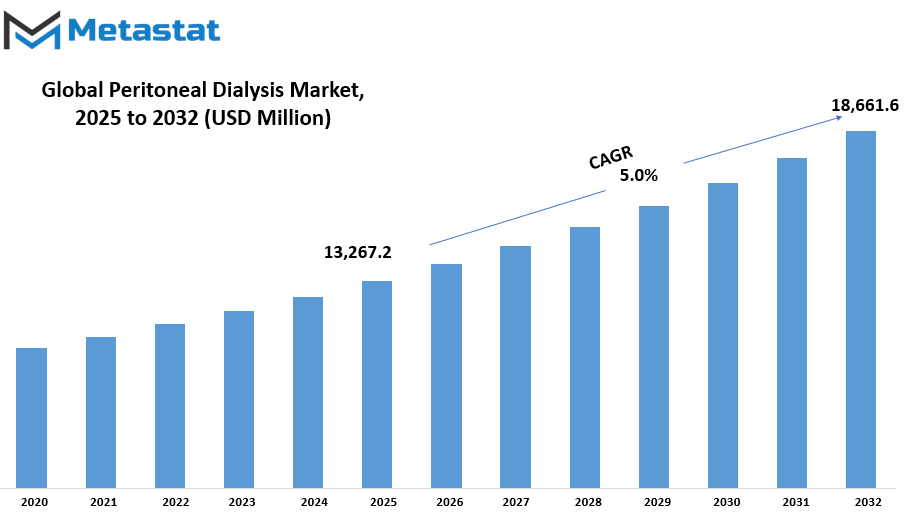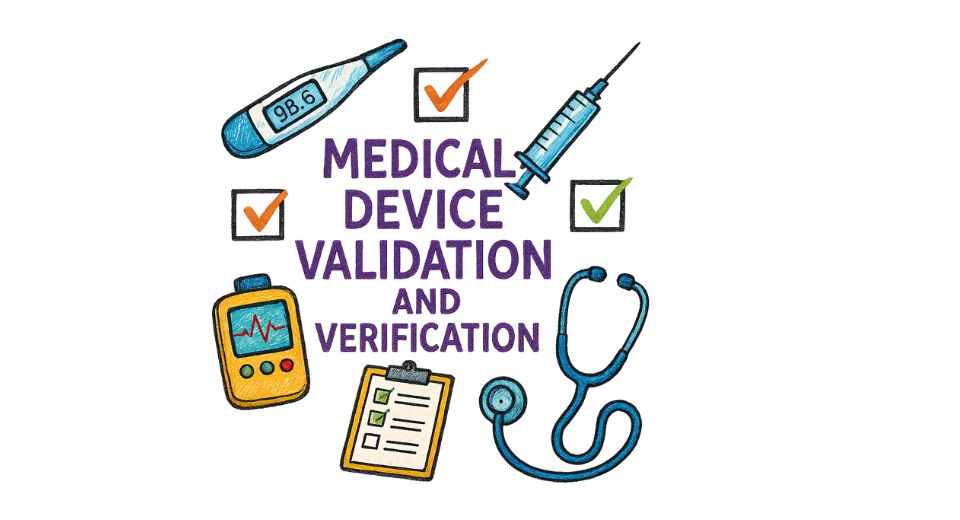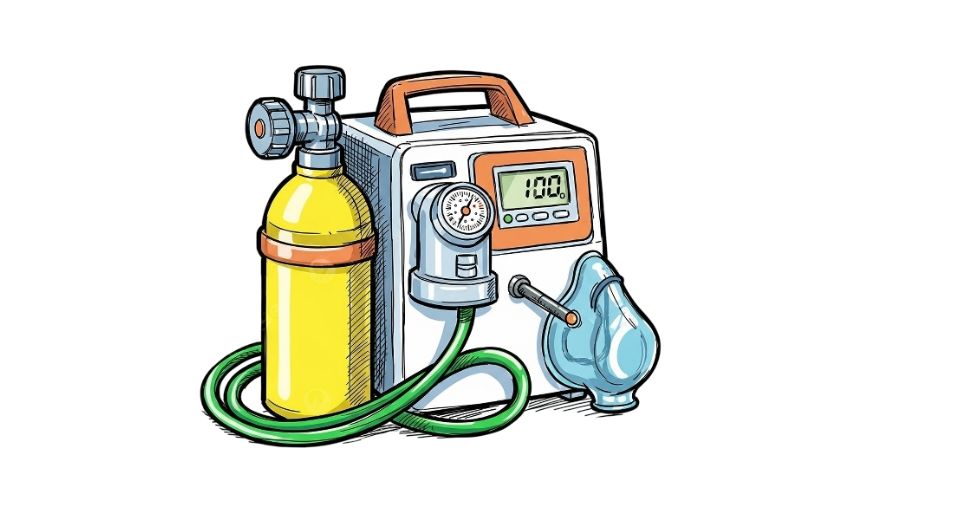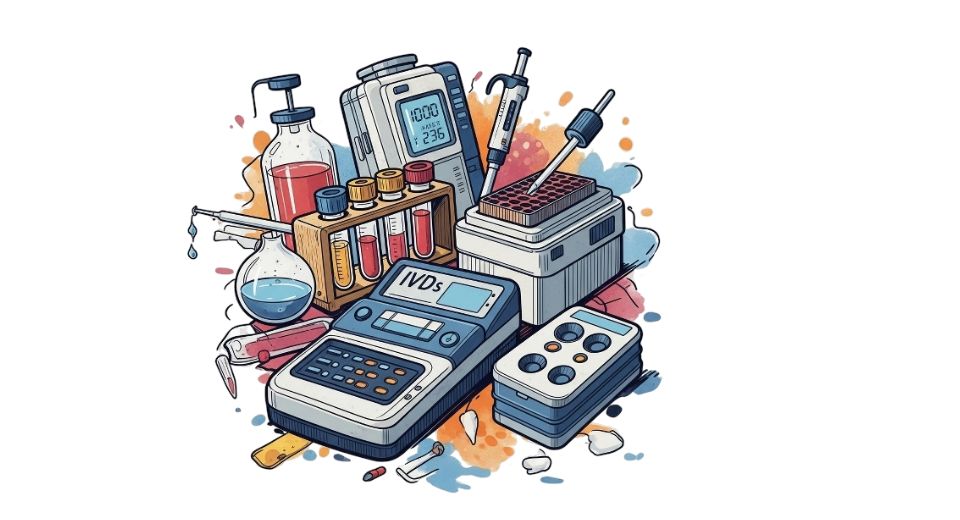MARKET OVERVIEW
The Global Peritoneal Dialysis market is located in a high-level arena that has been attracting attention due to its critical role in renal healthcare management. While much literature discusses product innovations, treatment efficacy, and patient outcomes, an under-researched dimension focuses on critical concerns outside immediate clinical applications. What lies ahead for the domain is a different ball game away from the things already known, a paradigm shift that would reorganize how peritoneal dialysis itself fits into the wider ecosystem of chronic disease care, healthcare delivery models, and regional disparities.
The future of the Global Peritoneal Dialysis market shall move toward enunciating patient access, health infrastructure, and logistics. Areas currently underrepresented in peritoneal dialysis uptake will begin to be foregrounded, not just for geographical expansion but in terms of tailored solutions that respond to specific demographic, cultural, and economic variables. These areas cannot take a similar developmental journey with established markets. Instead, they must carve out their unique pathways, taking on-board local workforce capabilities, training models, and supply chain viability.
Another dimension that will shape the future trajectory of this market involves how it interacts with digital healthcare systems. There is lots of talk about automating the dialysis process; an alternative narrative is emerging around issues of data ownership, home monitoring, and decentralized care that is likely to pick up traction. The challenge will not be technology but how to maintain the human aspect-considering patient autonomy, understanding, and trust-into increasingly complex systems. New questions on ethics, privacy, and the long-term implications of remote monitoring will soon enter the Global Peritoneal Dialysis market as care continues to shift further into patients' homes.
Making drastic changes to the current peritoneal dialysis workforce will also be in store. Training for nephrology nurses, home-care providers, and technicians will move toward a community-based curriculum with proper integration into technology. This transformation will demand a financial investment and a cultural shift in caregivers' orientation and practice toward urban-and rural-based settings. Over time, the structure of support networks around dialysis patients will begin to reflect broader societal shifts, such as aging populations and evolving household dynamics.
Environmental considerations will also acquire urgency. As a growing consciousness emerges concerning the sustainability debate on a global scale, peritoneal-associated materials and waste will become the focus. It may no longer be a matter of just rendering the treatment effective; the evaluation of long-term sustainability of this treatment will so include considerations regarding the impact of that treatment on local waste systems, water, and energy consumption.
Global Peritoneal Dialysis market is estimated to reach $18,661.6 Million by 2032; growing at a CAGR of 5.0% from 2025 to 2032.

GROWTH FACTORS
The global peritoneal dialysis market is going to be growing due to the increasing number of patients being diagnosed with end-stage renal disease (ESRD), which requires treatment to remove from the body wastes, excess fluid, and toxins that accumulate when the kidneys cease to function normally. Although it is not intended to be a permanent solution, peritoneal dialysis is quite flexible for use than hemodialysis since many patients can even do it at home. With more and more persons affected by kidney failure in the world, it further raises the requirement for effective and manageable dialysis procedures.
Growth in technology development concerning peritoneal dialysis solution is also presently enjoying the market boost. Innovations render treatment procedures easier, more comfortable, and safer to the patients. Improvements involve better dialysis fluids, more user-friendly machines, and tools that will contribute to an accurate monitoring of treatment. The intents at ensuring both improvement in the quality of life of patients and complication possibility reduction are achieved. As interchange continues to well thrive in technology, peritoneal dialysis is becoming increasingly appealing to healthcare providers and patients alike.
In spite of this positive environment, the market continues to face some challenges. The most significant is limited reimbursement support by most countries. Without adequate financial assistance, very often, patients find it difficult to pay for long-term dialysis treatment. This is more acute in nations with tight healthcare budgets or where insurance does not cover much of the costs incurred. There is also the issue of lack of awareness or access in some developing regions. Many patients and even health professionals are not so aware of the benefits of peritoneal dialysis, and facilities for this treatment may not be within reach for some areas.
Yet, there is considerable potential to grow because more patients and doctors are realizing the benefits of home-based care. Home-based peritoneal dialysis allows patients to be cultured in their own environment while promoting a more normal life. It minimizes frequent visits to the hospital which can be useful when distances are great from a medical center. Demand for home-based peritoneal dialysis will increase as health systems strive towards convenience and value-based treatment for patients. This trend will provide fertile ground for market growth prospectively in the next few years.
MARKET SEGMENTATION
By Product and Services
The global peritoneal dialysis market is continuously growing because of increased requirements for effective and manageable care by more persons everywhere. Compared to traditional in-center hemodialysis, this type of dialysis allows patients to carry on with their regular day-to-day activities but much more smoothly. It filters waste from the blood using the lining of the abdomen as a means. This makes it much more convenient for many. The increasing incidence of end-stage renal disease patients, advancing awareness on home-based dialysis options, and better healthcare infrastructure are contributing to the rising demand for peritoneal dialysis. Along with this growing demand is an increasing need for reliable products and services in support of patients on the one side and providers on the other.
Peritoneal dialysis: Products & Services Segmentation. The peritoneal dialysis market segmentation on the products and services usage differentiates Peru on the other products. It includes Peritoneal Dialysis Solutions, which are valued at a significant share of $2,928.3 million. These products tend to be important in the process of purification by clearing the wastes and a surplus of liquid in the body. Another major importance of Peritoneal Dialysis Machines is to make the process of treatment simple and effective, especially for those using the automatic option. Peritoneal Dialysis Catheters are also an essential part of it, as these help in safely delivering the dialysis solution into the abdominal cavity. And transfer sets make things easy for patients during the connection and disconnection parts of their treatment. Other products help to support the whole treatment process with various additional tools and accessories that improve comfort, safety, and ease of use. Peritoneal Dialysis Services seamlessly integrate with these, providing various support aspects such as patient training, monitoring, and continuing care to help patients adhere to their treatment plans in managing their conditions.
It is a public-private partnership investing in better treatment options that is fueling growth in this market. Increasingly, healthcare providers are advocating home-based dialysis for fewer visits to hospitals and a sense of control over treatment management directed by patients at home. Personalized care and high-tech medical technologies are also working to advance this market. Now all in synergy, the Global Peritoneal Dialysis market is forecasted to grow much further in the years ahead, leading to improved treatment outcomes and better lives for patients dependent on these life-saving treatments.
By Modality
Here are some excerpts from sample text to convince potential readers besides above original ones. Factors like an increase in the growing number of people suffering from renal diseases, make the right treatment options, and carry global peritoneal dialysis markets into good health and stability. As the term connotes, peritoneal dialysis is a method to remove waste or fluids from the blood when the kidneys cannot. In contrast to hemodialysis, this uses the lining of the abdominal cavity for the filtration of blood instead of the machine.
This treatment can also be done at home, and thus a selection of many people seeks this means to stay out of the hospital. The market is segmented into two modalities: Continuous Ambulatory Peritoneal Dialysis and Automated Peritoneal Dialysis. Continuous Ambulatory Peritoneal Dialysis, or CAPD, is basically the manual old style of doing peritoneal dialysis as it does not use a mechanical device and is done several times a day. The patient fills the abdomen with special dialysate fluid via the catheter, allows it to stay in the abdomen for a few hours, and then drains it. This alternative allows flexibility and autonomy over a schedule but requires discipline in its daily use. Automated Peritoneal Dialysis, on the other hand, provides a machine that automatically executes the exchange. This generally happens at night while the patient sleeps. This type of dialysis is, therefore, mostly preferred by those wishing to minimize disruption of normal life during the day.
The choice between these methods will mainly depend on an individual's lifestyle, health status, and preferences. There is no distinction between both methods regarding their effectiveness, and usually, healthcare professionals provide guidance in choosing one over the other among patients. The increasing number of patients under dialysis goes hand in hand with an increasing demand for both CAPD and APD. Besides, the technology has been improving APD machines and making them more comfortable and easier to use. Lastly, due to growing awareness regarding home-based dialysis treatments, people tend to see peritoneal dialysis as a long-term option.
These efforts would ensure the hospitals were released from the burden of care at some point in the near future. These will also definitely make the treatment easier and effective in need cases with previous studies. The Global Peritoneal Dialysis Market is waiting for good times in its profile with acceptance to meet the needs of the patient population that keeps expanding.
By End-User
Globalization and Import Markets for Peritoneal Dialysis: Growth Trends Steady in Peritoneal Dialysis: Growth Steady The continued rise in the number of patients with kidney-related issues, along with the growing need for affordable treatment options, is driving the Global Peritoneal Dialysis market. Peritoneal dialysis, in this sense, provides very convenient alternatives to home care for patients with chronic kidney disease, as it does not require frequent hospital visits. In fact, people in areas with limited access to large medical centers will find this treatment modality quite beneficial. Besides the growing awareness regarding this treatment, advancements in technology that increase quality and efficiency in dialysis equipment encourage an increasing number of patients to consider as reliable.
The end-user segmentation of Hospitals, Dialysis Centers, and Home Healthcare Settings is there within the market further. Hospitals will still play a very important role in initiating treatment and monitoring patients in the early stages. They will also handle complicated cases, which would need very close monitoring by medical professionals. Dialysis centers have become equally popular, as they specifically provide care by trained staff and advanced machines to facilitate the treatment process. Such centers often visit larger hospitals, but they provide a less stressful environment reducing stress for all those involved in the process.
Home Healthcare Settings become increasingly strong in the market driven mainly by the preference for treatments at home. More patients now are undergoing dialysis at a home which allows them to continue with their daily routines as well as enjoy more independence. It also reduces the load on healthcare and enhances. More omnipresent and flexible items freed up by manufacturers integrate easy-to-work with devices and instructions to facilitate patient safety at home. Flexibility and cost efficiency has made home treatment attractive to both patients and caregivers.
With the emphasis on best outcomes in a low-cost environment, countries all over the world will witness further increases in demand for dialysis services that are most cost efficient in delivery. Each end-user group plays an important role in supporting this treatment: the structured care in hospitals and the specialized approach with the efficacy of dialysis centers, as well as the trust in home healthcare growing. This balanced support across different settings will also ensure that more people will be able to receive the treatment that they require by the approach best suited to their needs.
By Other Products
The Peritoneal Dialysis market is estimated to grow continuously across the globe, and the various types of products play a crucial role in supplementing kidney-failure patients. Amongst these segments, "By Other Products," within this market, several important types of dialysis solutions are combined to meet specific medical needs of individual people. These include Standard Dialysate Bags, Dual-Chamber Bags, Icodextrin Bags, Biocompatible Bags, and Others. Each of these products has its own purpose and contributes to the overall treatment process in a different way.
Standard Dialysate Bags are the most commonly used type. They contain a balanced mixture of electrolytes and glucose and comprise mostly routine dialysis treatment. These bags help to eliminate waste and excess fluids from the body, imitating the functions of healthy kidneys. Their simplicity and easy availability make them a trusted option for many patients. Dual-Chamber Bags, on the other hand, provide a much more controlled mixing procedure. These are bags separated into two compartments—one having acid solution and the other base solution. Just before the usage, the two parts are combined to prepare a fresh solution. This method helps decrease solution deterioration risk and might improve safety and efficacy during the dialysis process.
Icodextrin Bags are meant for longer sessions of dialysis. Unlike glucose-based solutions, icodextrin works differently, in that it uses a starch-derived material. This benefit helps patients to attain better fluid control, especially where dialysis is done over the night or for many hours during the day. It is mostly used among patients having issues with fluid overload. Another important product in this category is Biocompatible Bags. These are made to be less harsh on the peritoneal membrane. Common solutions might irritate or hurt the lining of the abdomen by using them regularly, but biocompatible solutions aim at lessening that risk. These are especially helpful for long-term treatment, and perhaps, in due time, may show better results among patients.
The "Other" section has specialized or new solutions which are still in research and development or rarely used. These might either be new approaches or be used for highly specialized patients' needs. Each product listed under this segment brings more options to the patients and enhances their quality-of-life experience during their treatment. As such, as these medical needs evolve, so will the demand for any or all of these types of peritoneal dialysis products grow.
|
Forecast Period |
2025-2032 |
|
Market Size in 2025 |
$13,267.2 million |
|
Market Size by 2032 |
$18,661.6 Million |
|
Growth Rate from 2025 to 2032 |
5.0% |
|
Base Year |
2024 |
|
Regions Covered |
North America, Europe, Asia-Pacific, South America, Middle East & Africa |
REGIONAL ANALYSIS
Geographically, the global Peritoneal Dialysis market can be divided into North America, Europe, Asia-Pacific, South America, Middle East, and Africa. North America accounts for the USA, Canada, and Mexico. Each of these countries has different levels of access to health care; not very strong market-wise, however, considering their highly advanced medical infrastructure and awareness regarding dialysis treatments, this forms quite a strong market. The reason for North America being so large is that very few people are found to be below the age of 65 years; the number of kidney diseases is also growing.
The market in Europe thus comprises UK, Germany, France, Italy, and few more countries grouped under Rest of the Europe. This region is known for its well-defined healthcare systems and persistent investments in medical technology. Germany and UK are majorly progressive towards providing peritoneal dialysis as an option for treating patients, making it easier for home care services to be set up. This in turn has inspired more patients to access this option thus leading to a gradual increase in market share across the region.
Asia Pacific is another important segment of the world market, which is subdivided into the following: India, China, Japan, South Korea, and other neighbouring countries, grouped under Rest of the Asia Pacific. The region has very large populations and much rising health concern, especially in kidney cases. Some countries in this group are still lagging in thier healthcare access, whereas some like Japan and South Korea are very advanced, offering various treatment options. India and China are fast developing the dialysis market due to increasing awareness and government efforts to improve healthcare facilities.
This region comes to South America, which includes Brazil, Argentina, and the Rest of South America. Brazil is one of the key countries under this region because it has a huge number of increasing dialysis patients and expanding access to medical care. This trend is being followed by Argentina and the rest of the region but comparatively slowly, with an increased interest rate in peritoneal dialysis.
Lastly, the Middle East and Africa region is divided into GCC Countries, Egypt, South Africa, and the Rest of the Middle East and Africa. These areas will increasingly show their potential for expanding health investments and increasing awareness about the treatments for kidney diseases. Leading this area is the UAE and Saudi Arabia within the GCC countries.

COMPETITIVE PLAYERS
Owing to a surge in incidents of kidney-related disorders, especially in home-based treatment options, the dawn of steady growth for the Global Peritoneal Dialysis market was in place. Peritoneal dialysis allows most of the patients to manage their issues without being frequently hospitalized; hence, this treatment becomes a major convenience to quite a handful of patients. On the raise are patient awareness and treatment benefitting variables such as flexibility and maintenance of better lifestyle, pushing the demand further for peritoneal dialysis treatment.
Various companies are somehow involved in the growth and development of the Peritoneal Dialysis market. Major participants are Fresenius Medical Care AG, DaVita Inc, Baxter International Inc and U.S. Renal Care, Inc. These companies tend to focus on the modernization of current technologies while producing avant-garde options enhancing comfortability and effectiveness of the dialysis practice. Other sizable market players include Nipro Corporation, B. Braun Medical Ltd, JMS Co., Ltd. and Terumo Corporation. These companies are producing treatments that meet the increasingly assorted needs of the patients while innovating to reduce complications and ensure safety during treatment.
Mozarc Medical Holding LLC and Merit Medical Systems, Inc. hold a critical position in providing access to new devices for easier dialysis. Northwest Kidney Centers and Utah Medical Products, Inc. support patients in their dialysis journey with services and tools, while newer companies striving to create a competitive edge with innovative methods are Huaren Pharmaceutical and Poly Medicure Ltd.
Medical Components, Inc., WEGO Healthcare (Shenzhen) Co., Ltd., Medionics International Inc., and Renax Biomedical Tech. Co., Ltd. are also engaged in developing user-friendly systems and devices that are easy to operate from home. Newsol Technologies Inc. and Mitra Industries Private Limited have provided their own cutting-edge products and solutions to respond to the ever-changing patient requirements. Other companies such as Sanderling Healthcare and ADMS (Atlantic Dialysis Management Services) have been enhancing the experience of dialysis patients by providing high-quality care and excellent support systems. Convenience and accessibility are unparalleled since AWAK Technologies launched portable dialysis.
The market will continue to grow as increasing numbers of people choose peritoneal dialysis for its comfort and flexibility. With continued improvement and the commitment of said companies, the future of peritoneal dialysis has brightened into a lesson of hope and better care for patients everywhere.
Peritoneal Dialysis Market Key Segments:
By Product and Services
- Peritoneal Dialysis Solutions
- Peritoneal Dialysis Machines
- Peritoneal Dialysis Catheters
- Peritoneal Dialysis Transfer Sets
- Other Products
- Peritoneal Dialysis Services
By Modality
- Continuous Ambulatory Peritoneal Dialysis
- Automated Peritoneal Dialysis
By End-User
- Hospitals
- Dialysis Centers
- Home Healthcare Settings
By Other Products
- Standard Dialysate Bags
- Dual-Chamber Bags
- Icodextrin Bags
- Biocompatible Bags
- Others
Key Global Peritoneal Dialysis Industry Players
- Fresenius Medical Care AG
- DaVita Inc.
- Baxter International Inc.
- U.S. Renal Care, Inc.
- Nipro Corporation
- B. Braun Medical Ltd
- JMS Co., Ltd.
- Terumo Corporation
- Mozarc Medical Holding LLC
- Merit Medical Systems, Inc.
- Northwest Kidney Centers
- Utah Medical Products, Inc.
- Huaren Pharmaceutical
- Poly Medicure Ltd
- Medical Components, Inc.
- WEGO Healthcare (Shenzhen) Co., Ltd.
- Medionics International Inc.
- Renax Biomedical Tech. Co., Ltd.
- Newsol Technologies Inc.
- Mitra Industries Private Limited
- Sanderling Healthcare
- ADMS (Atlantic Dialysis Management Services)
- AWAK Technologies
WHAT REPORT PROVIDES
- Full in-depth analysis of the parent Industry
- Important changes in market and its dynamics
- Segmentation details of the market
- Former, on-going, and projected market analysis in terms of volume and value
- Assessment of niche industry developments
- Market share analysis
- Key strategies of major players
- Emerging segments and regional growth potential








 US: +1 3023308252
US: +1 3023308252






